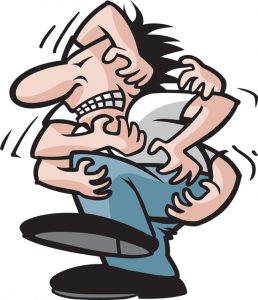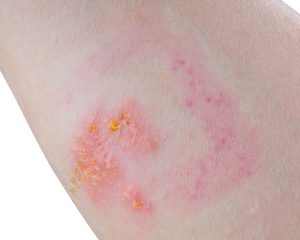Poison Ivy Treatment: It’s Called “Poison” for a Reason
Careful as you've been while spending time outdoors, you somehow came down with the maddening rash that erupts from poison ivy. What's the right course of action? We steer you in the right direction by answering 10 frequently asked questions about poison ivy treatment.
People who haven’t had a poison ivy experience know that poison ivy is a poisonous plant, it causes a rash, and it eventually goes away. People who have had an episode know there’s a lot more to it—and that they will probably handle the situation differently if a “next time” occurs. Poison ivy treatment starts with prevention—identifying and recognizing the plant and avoiding it, or wiping away traces of its urushiol oil as quickly as possible after contact. Sometimes, however, you unwittingly find yourself exposed to urushiol oil, and the rash begins making its presence felt.
With that in mind, here are 10 frequently asked questions and answers about poison ivy treatment.
1. What makes poison ivy so itchy?
Poison ivy is called “poison” for a reason. Poison is a substance whose chemical action kills, injures, or impairs an organism. Poison ivy doesn’t kill, but it certainly injures and impairs. The villain that makes it itchy is urushiol, an oil that causes an allergic reaction in the form of a blistering rash and an impossible-to-ignore itch.
By the way, sensitivity to urushiol changes over time—even from season to season. People who were sensitive to poison ivy as children may not be allergic as adults. And people who were not sensitive earlier in life may now be sensitive.

You tried to avoid it, but you suddenly realize that you’ve come into contact with urushiol oil—and are badly in need of poison ivy treatment.
2. What is the most effective poison ivy treatment?
There are several—some you can do at home; some by seeing a doctor. Let’s start with at-home measures.
- Flush the skin with lukewarm soapy water as soon as possible. Every minute counts.
- Don’t scratch. Bacteria on your hands can infect the skin where it is scratched.
- Don’t break the blisters.
- Use wet compresses to relieve itching.
- Apply over-the-counter topical corticosteroid medications, or…
- Apply skin protectants that contain zinc carbonate, zinc oxide, or zinc acetate (to dry the areas), or…
- Apply calamine lotion (for itchiness) or Aveeno (to protect and relieve itchiness), or…
- Use baking soda or colloidal oatmeal (to relieve irritation and itchiness).
The National Institute for Occupational Safety and Health recommends applying rubbing alcohol, a specialized poison plant cleanser (see examples below), or degreasing soap (such as dishwashing liquid), and rinsing well with water.
3. Are some topical creams better than others?
Topical creams are designed for specific problems. As noted above, baking soda and oatmeal relieve itchiness. Zinc carbonate/oxide/acetate protects the skin, and aluminum acetate addresses the rash. Calamine Lotion dries the affected areas.
Do not use:
- Antihistamine creams or lotions
- Anesthetic creams with benzocaine
- Antibiotic creams with neomycin or bacitracin
They may make the condition worse.
4. What is Tecnu, and how long should you use it for poison ivy?
Tecnu is a product used to help remove urushiol oil before the rash develops. It should be applied within two to six hours after exposure. Once the rash has developed, Tecnu removes oil on the skin and allows the healing process to start. Tecnu has six ingredients, including soap, fragrance, and water. It can also be used to clean pets, clothing, and tools.
Other products that remove urushiol are Dawn Dishwashing Liquid, Purell Naturals Hand Sanitizer, Covidien Webcol Alcohol Prep Pads, All Terrain Poison Ivy/Oak Bars, and IvyX Post-Contact Skin Cleanser
5. Does Benadryl help relieve itching?
Benadryl helps with the itching but does not speed up the healing process.
6. How long does it take to cure poison ivy rash?
In most cases, poison ivy rashes last five to 12 days, but severe episodes can last for 30 days or longer.
7. At what point should you see a doctor?

When should poison ivy treatment involve a doctor’s care? The presence of pus and scabbing may be signal.
The Food and Drug Administration recommends seeing a doctor if:
- You have a temperature of 100+ degrees Fahrenheit.
- There is pus, soft yellow scabs, or tenderness at the site of the rash.
- The itching gets worse or keeps you awake at night.
- The rash does not improve over a period of weeks.
A doctor can prescribe medications that are more effective than over-the-counter products. Prednisone is an example. If the rash is infected, you may also need a prescription-strength oral antibiotic.
8. At what point should get emergency care?
- When you have difficulty breathing or swallowing.
- When one or both eyelids are swollen shut.
- When the rash is on your face or genitals, or covers more than 25 percent of your body.
9. Is poison ivy contagious?
It is not contagious and does not spread once you have washed the oil off the skin. Although it might appear to spread, it’s more likely to be a delayed action to urushiol in different areas of exposure.
10. Should you simply wash the clothes you were wearing, or should you throw them away?
Wash your clothing enough to get the oil out, whether it’s once, twice, or more. Once usually does it, but it may make you feel safer if you wash, rinse, and repeat. Wash your clothes separately from other clothing, using the hottest water, largest load size, and longest cycle.
Other tips to keep urushiol at bay:
- Clean the laundry hamper that contained the clothes by scrubbing it with some detergent and hot water.
- Wash shoes and other items by hand (using rubber gloves), but be sure to throw away any sponges or brushes that might still hold urushiol.
- Wash your gardening tools, camping gear, sports equipment, and anything else that comes into contact with the plant. Urushiol can stay on those objects for decades unless washed off.
- Wash your pet if it has come into contact with poison ivy, poison oak, or sumac. Use a pet shampoo and wear rubber gloves. Most pets are not sensitive to poison ivy, but the oil can stick to their fur and rub off on a person.
Better Than Treatment?
Again, the best poison ivy treatment is prevention. Learn what poison ivy looks like—and also study up on the appearance of poison oak and poison sumac look like, and then try to avoid them and, if you spot them on your property, get rid of the plants—roots and all. (See also Poison Ivy: America’s Rash.)
If you think you might be coming into contact with the plant, try a product like IvyX Pre-Contact Skin Poison Ivy Wipes. IvyBlock, once approved by the FDA to protect the skin against poison ivy, is no longer on the market.


 Vestibular Migraine Diet
Vestibular Migraine Diet  Bone Spurs on the Spine
Bone Spurs on the Spine  Knee Injections for Osteoarthritis Pain Relief
Knee Injections for Osteoarthritis Pain Relief 
The keys to poison ivy treatment are to rid yourself of the urushiol oil that started your rash—and then to dry it out while controlling the itching with such products as calamine lotion, among others discussed here.
© Nathanphoto | Dreamstime.com